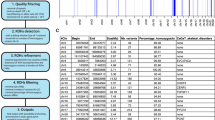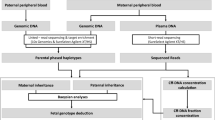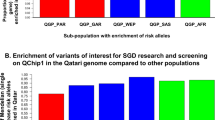Abstract
Genomic mismatch scanning (GMS) is a technique that enriches for regions of identity by descent (IBD) between two individuals without the need for genotyping or sequencing. Regions of IBD selected by GMS are mapped by hybridization to a microarray containing ordered clones of genomic DNA from chromosomes of interest. Here we demonstrate the feasibility and efficacy of this form of linkage-mapping, using congenital hyperinsulinism (HI), an autosomal recessive disease, whose relatively high frequency in Ashkenazi Jews suggests a founder effect. The gene responsible (SUR1) encodes the sulfonylurea receptor, which maps to chromosome 11p15.1. We show that the combination of GMS and hybridization of IBD products to a chromosome-11 microarray correctly maps the HI gene to a 2-Mb region, thereby demonstrating linkage-disequilibrium mapping without genotyping.
This is a preview of subscription content, access via your institution
Access options
Subscribe to this journal
Receive 12 print issues and online access
$209.00 per year
only $17.42 per issue
Buy this article
- Purchase on Springer Link
- Instant access to full article PDF
Prices may be subject to local taxes which are calculated during checkout
Similar content being viewed by others
References
Ewens, W.J., Spielman, R.S. & Harris, H. Estimation of genetic variation at the DNA level from restriction endonuclease data. Proc. Natl. Acad. Sci. USA 6, 3748–3750 (1981).
Cooper, D.N., Smith, B.A., Cooke, H.J., Niemann, S. & Schmidte, J. An estimate of unique DNA sequence heterozygosity in the human genome. Hum. Genet. 69, 201–205 (1985).
Nelson, S.F. et al. Genomic mismatch scanning : a new approach to genetic linkage mapping. Nature Genet. 4, 11–18 (1993).
Mirzayans, F., Mear, A.J., Guo, S.-W., Pearce, W.G. & Walter, M.A. Identification of the human chromosomal region contain the iridogoniodysgenesis anomaly locus by genomic mismatch scanning. Am. J. Hum. Genet. 61, 111–119 (1997).
Cheung, V.G. & Nelson, S.F. Genomic mismatch scanning identifies human genomic DNA shared identical by descent. Genomics 47, 1–7 (1998).
McAllister, L., Penland, L. & Brown, P.O. Enrichment for loci identical-by-descent between pairs of mouse or human genomes by genomic mismatch scanning. Genomics 47, 8–14 (1998).
Aguilar-Bryan, L. et al. Cloning of the β-cell high-affinity sulfonylurea receptor: a regulator of insulin secretion. Science 268, 423–425 (1995).
Thomas, P.M. et al. Mutations in the sulfonylurea receptor gene in familial persistent hyperinsulinemic hypoglycemia of infancy. Science 268, 426–428 (1995).
Nestorowicz, A. et al. Mutations in the sulfonylurea receptor gene are associated with familial hyperinsulinism in Ashkenazi Jews. Hum. Mol. Genet. 5, 1813–1822 (1996).
Au, K.G., Welsh, K. & Modrich, P. Initiation of methyl-directed mismatch repair. J. Biol. Chem. 267, 12142–12148 (1992).
Casna, N., Novack, D., Hsu, M. & Ford, D. Genomic analysis II: isolation of high molecular weight heteroduplex DNA following differential methylase protection and formamide-PERT hybridization. Nucleic Acids Res. 14, 7285–7303 (1986).
Modrich, P. DNA mismatch correction. Ann. Rev. Biochem. 56, 435–466 (1987).
Su, S.S., Lanhue, R.S., Au, K.G. & Modrich, P. Mispair specificity of methyl-directed DNA mismatch correction in vitro. J. Biol. Chem. 263, 6829–6835 (1988).
Smitha, J & Modrich, P. Mutation detection of MutH, MutL, and MutS mismatch repair proteins. Proc. Natl. Acad. Sci. USA 93, 4374–4379 (1996).
Jorde, L.B. Linkage disequilibrium as a gene-mapping tool. Am. J. Hum. Genet. 56, 11–14 (1995).
Risch, N. & Merikangas, K. The future of genetic studies of complex human diseases. Science 273, 1516–1517 (1996).
Glaser, B. et al. Recombinant mapping of the familial hyperinsulinism gene to an 0.8 cM region on chromosome 11p15.1 and demonstration of a founder effect in Ashkenazi Jews. Hum. Mol. Genet. 4, 879–886 (1995).
Qin, S. et al. A Chromosome 11 YAC library. Genomics 16, 580–585 (1993).
Qin, S. et al. A high-resolution physical map of human chromosome 11. Proc. Natl. Acad. Sci. USA 93, 3149–3154 (1996).
Stanley, C.A. & Baker, L. Hyperinsulinism in infants and children: Diagnosis and therapy. Advances Pediatr. 23, 315–355 (1976).
Glaser, B. et al. Familial hyperinsulinism maps to chromosome 11p14–15.1, 30 cM centromeric to the insulin gene. Nature Genet. 7, 185–188 (1994).
Ayyagari, A. et al. Construction of a YAC contig encompassing the Usher Syndrome Type 1C and familial hyperinsulinism loci on chromosome 11p14 –15.1. Genome Res. 6, 504–514 (1996).
Kerem, B.S. et al. Identification of the cystic fibrosis gene: Genetic analysis. Science 245, 1073–1080 (1989).
Risch, N. et al. Genetic analysis of idiopathic torsion dystonia in Ashkenazi Jews and their descent from a small founder population. Nature Genet. 9, 152–159 (1995).
Hästbacka, J. et al. Linkage disequilibrium mapping in isolated founder populations: diastrophic dysplasia in Finland. Nature Genet. 2, 204–211 (1992).
Sedat, J.W., Kelly, R.B. & Sinsheimer, R.L. Fractionation of nucleic acid on benzoylated-naphthoylated DEAE cellulose. J. Mol. Biol. 26, 537–540 (1967).
Henikoff, S. Unidirectional digestion with exonuclease III creates targeted breakpoints for DNA sequencing. Gene 28, 351–360 (1984).
Lengauer, C., Green, E.D & Cremer, T. Fluorescence in situ hybridization of YAC clones after Alu-PCR amplification. Genomics 13, 826–828 (1992).
Shalon, D., Smith, S.J. & Brown, P.O. A DNA microarray system for analyzing complex DNA samples using two-color fluorescent probe hybridization.Genome Res. 6, 639–645 (1996).
Author information
Authors and Affiliations
Rights and permissions
About this article
Cite this article
Cheung, V., Gregg, J., Gogolin-Ewens, K. et al. Linkage-disequilibrium mapping without genotyping. Nat Genet 18, 225–230 (1998). https://doi.org/10.1038/ng0398-225
Received:
Accepted:
Issue Date:
DOI: https://doi.org/10.1038/ng0398-225
This article is cited by
-
Robust physical methods that enrich genomic regions identical by descent for linkage studies: confirmation of a locus for osteogenesis imperfecta
BMC Genetics (2009)
-
A new method of preparing fiber-optic DNA biosensor and its array for gene detection
Science in China Series C: Life Sciences (2001)
-
Novel strategies to clone identical and distinct DNA sequences for several complex genomes
Molecular Biology (2000)
-
Making and reading microarrays
Nature Genetics (1999)
-
Who needs genetic markers?
Nature Genetics (1998)



